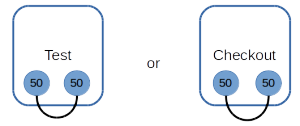Connascence of Value
Connascence is a way of describing the coupling between different parts of a codebase. And because it classifies the relative strength of that coupling, connascence can be used as a tool to help prioritise what should be refactored first.
For example, let’s tackle @pragdave‘s classic Back to the Checkout kata in Java. My first test checks that we can scan a single item and calculate the total correctly:
public class CheckoutTests {
@Test
public void basicPrices() {
Checkout checkout = new Checkout();
checkout.scan("A");
assertEquals(50, checkout.currentBalance());
}
}
Now I make it pass in the simplest way I can think of:
class Checkout {
public int currentBalance() {
return 50;
}
public Checkout scan(String item) { }
}
Clearly these two classes are now coupled (if they weren’t, the test wouldn’t pass). But is that coupling good or bad?
I can see three four kinds of connascence between the test and the production code:
Connascence of Name, because the test knows the names of the methods to call on the checkout object. This is level 1 (of 9) on the connascence scale — the weakest and least damaging form of coupling.
Connascence of Type, because the test knows which class to instantiate. This is level 2 on the scale, and is thus also relatively benign.
Connascence of Meaning, because both classes know that we are representing monetary values using ints. (I missed this first time around — d’oh!)
Connascence of Value, because both the test and the Checkout know the price of item “A”:
The Connascence of Value here means that the tests will break if I change the price of item “A”; I definitely wouldn’t want to release this into production.
Connascence of Value is level 8 on the scale of 9 types of connascence. The scale defines seven weaker forms of coupling, and only one more serious kind. I can use that model to help me prioritise the Refactor step in my TDD cycle: Connascence of Value is a serious problem, and should be fixed before I do anything else. The only question is: how?
The first thing I note is that connascence is weaker with proximity, which means that either of the following options would be preferable:
Thus, if I can move knowledge of the price of “A” so that only one of my classes has it, then the effects of the coupling are greatly diminished.
I can get some help from SOLID here, because the Dependency Inversion Principle also tells me that this code has a problem. The DIP says that we should depend on abstractions, not on details. And yet here I have a test that only works due to its knowledge of one of the details inside the production code.
The DIP (and @jbrains) also tells me what to do next: I should move the detail up towards the tests. That means I need to change the Checkout so that the test injects the value 50 via a parameter. I could pass it in via the scan method:
public class CheckoutTests {
@Test
public void basicPrices() {
Checkout checkout = new Checkout();
checkout.scan("A", 50);
assertEquals(50, checkout.currentBalance());
}
}
Alternatively I could inject it via the Checkout’s constructor:
public class CheckoutTests {
@Test
public void basicPrices() {
Checkout checkout = new Checkout(50);
checkout.scan("A");
assertEquals(50, checkout.currentBalance());
}
}
Either way, I have now removed the Connascence of Value between the Checkout and the test: I can change the price of item “A” by changing only one method.
The worst of the coupling is now gone, but I can do better. There is still Connascence of Value, albeit very localized, within that test method. Is it worth fixing?
I like my tests to be expressive and easy to read. I wouldn’t want to extract the value 50 to a constant, for example, because I would then have to scan up and down through the test class to discover exactly what the test was doing. But equally, that magic value 50 makes me a little nervous. Does it have business significance? Not in this case, and a new team member might not pick that up.
In cases such as this I like my tests to use random values, to help ensure that the code under test hasn’t made any unfortunate assumptions. So I replace that 50 with a call to a random price generator:
public class CheckoutTests {
@Test
public void basicPrices() {
Checkout checkout = new Checkout();
checkout.scan("A", randomPrice());
assertEquals(randomPrice(), checkout.balance());
}
}
But now the test is broken again, and that Connascence of Value is the guilty party, telling us that the two values need to be the same. I fix it by replacing the Connascence of Value by Connascence of Name:
public class CheckoutTests {
@Test
public void basicPrices() {
Checkout checkout = new Checkout();
int priceOfA = randomPrice();
checkout.scan("A", priceOfA);
assertEquals(priceOfA, checkout.balance());
}
}
To summarise, I find connascence useful in guiding my refactoring efforts during the TDD cycle. In this case, I weakened the coupling between the code and test by pushing details up the call stack; then I removed the Connascence of Value altogether by replacing it with Connascence of Name.

Kevin Rutherford's Blog
- Kevin Rutherford's profile
- 20 followers





